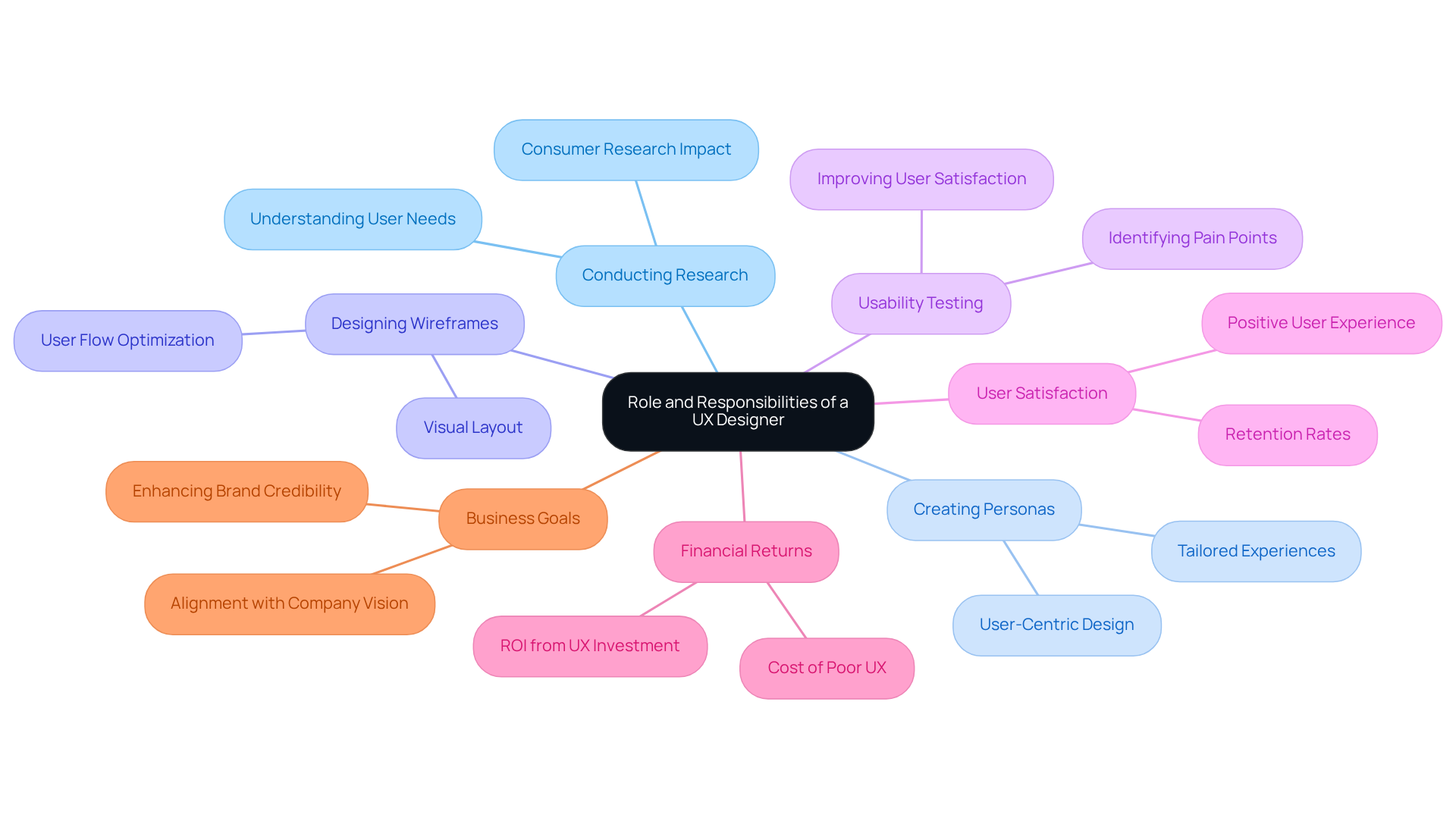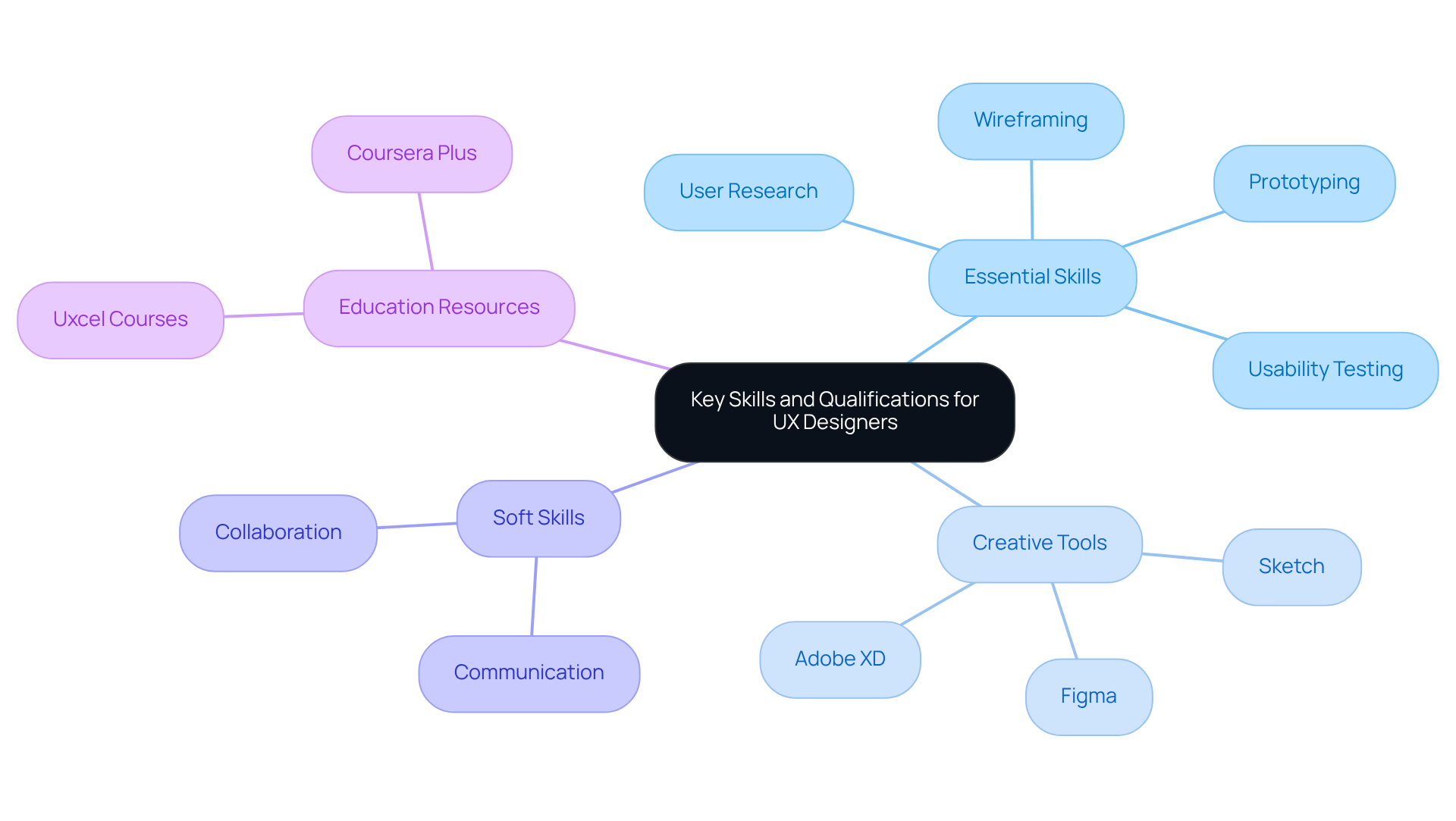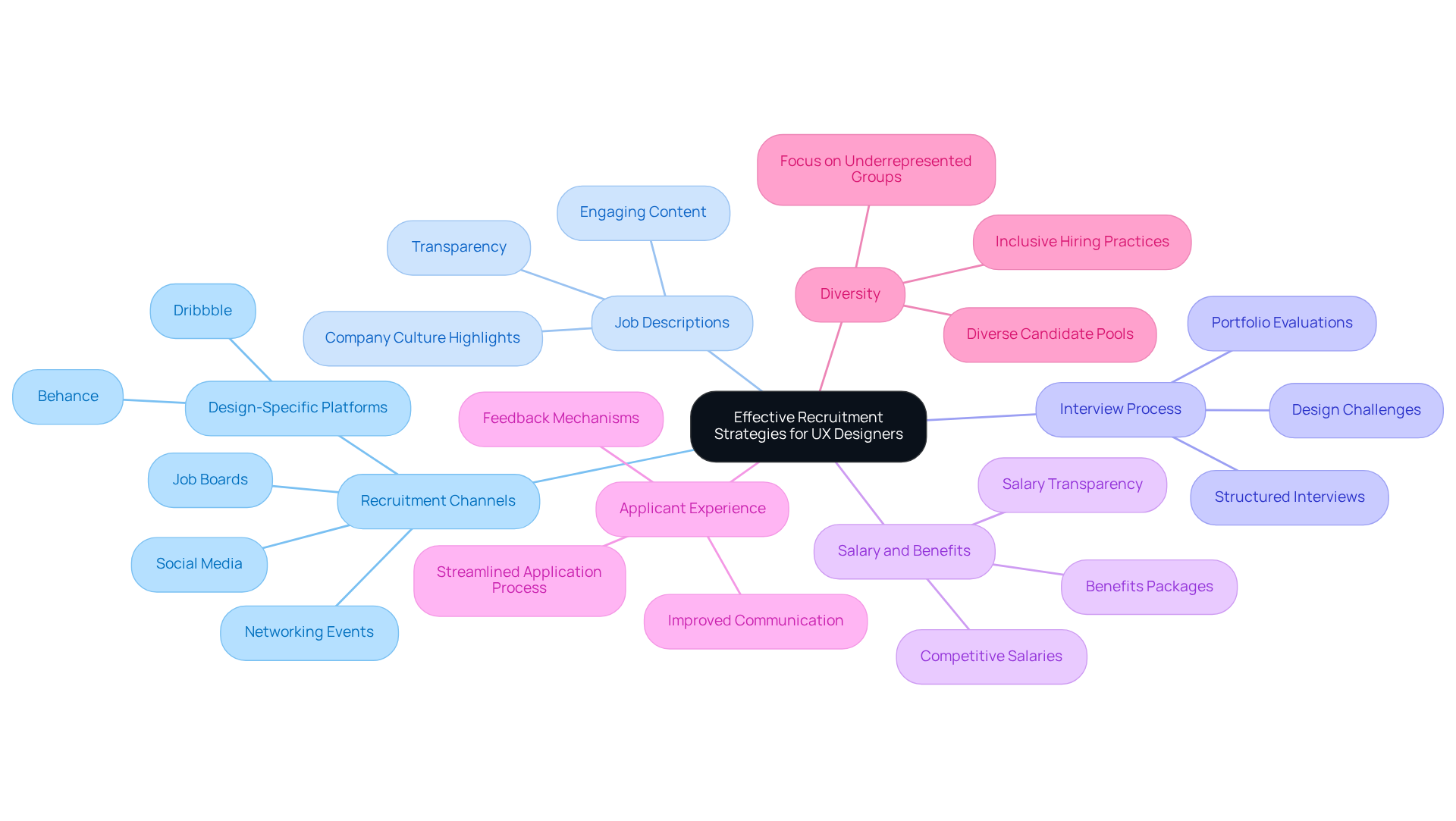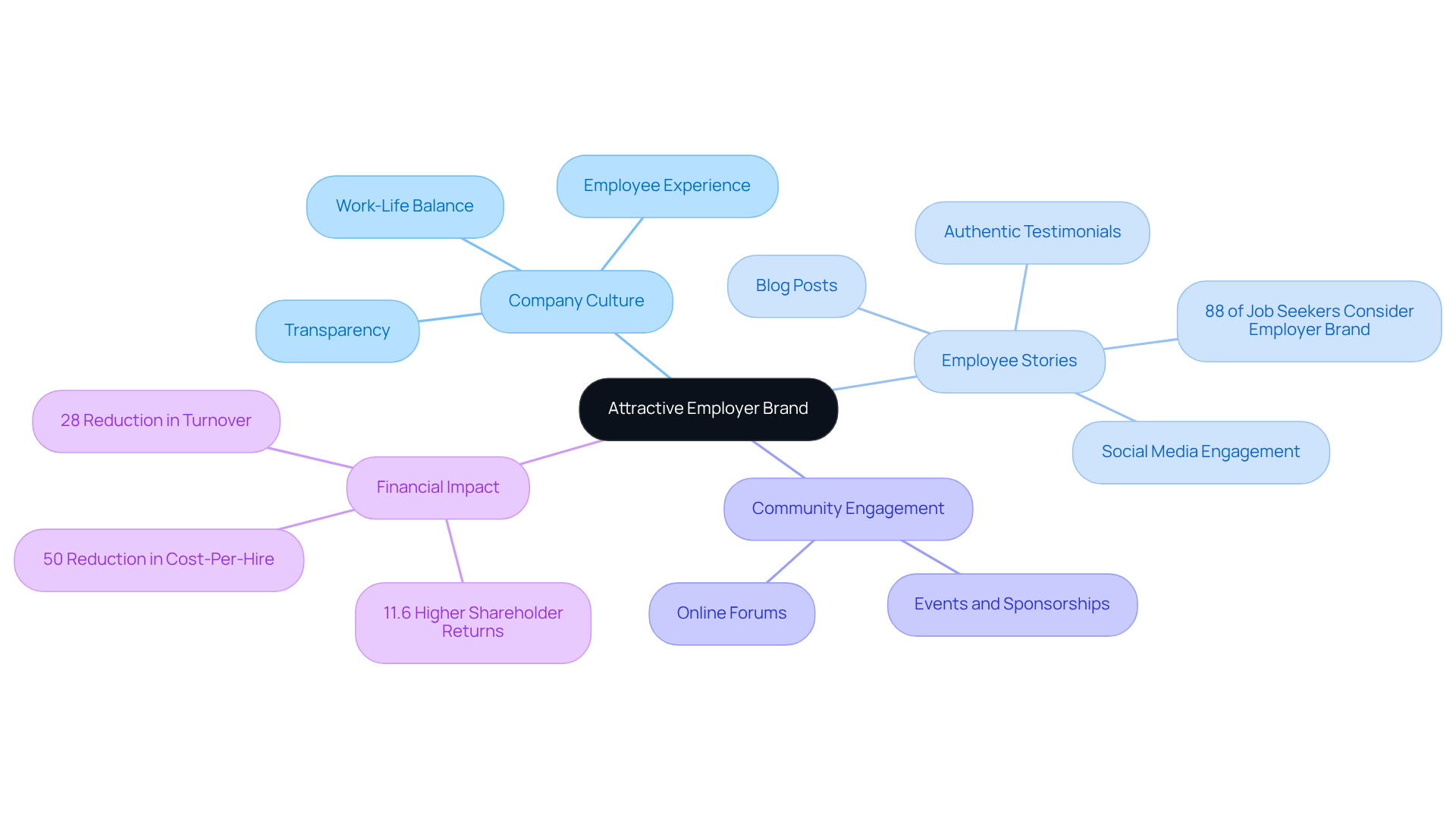Overview
Tech startups often face challenges in recruiting talented UI/UX designers, which can lead to frustration and setbacks. When the responsibilities of the role are not clearly defined, it can create confusion and misalignment within the team. This can impact not only the hiring process but also the overall user experience and business success. By acknowledging these pain points, we can explore how a well-structured approach can make a difference.
Imagine a scenario where a startup struggles to attract the right candidates. The stress of finding someone who not only possesses the essential skills but also fits the company culture can be overwhelming. This is where a nurturing approach can truly shine. By emphasizing:
- Competitive salaries
- Building a strong employer brand
- Focusing on diversity
startups can create an inviting atmosphere that appeals to potential hires.
Ultimately, implementing effective recruitment strategies can significantly improve the quality of hires and reduce turnover rates. This not only leads to better user experiences but also fosters a sense of community and belonging within the team. Remember, it's about creating an environment where designers feel valued and inspired to contribute to the startup's vision. Together, we can cultivate a supportive recruitment process that benefits everyone involved.
Introduction
In a landscape where user experience can truly make or break a tech startup, the quest for exceptional UI/UX designers becomes a heartfelt journey that many founders face. As businesses strive to create engaging and satisfying digital interactions, understanding the vital role and responsibilities of these designers is not just important; it’s essential.
This article explores effective recruitment strategies that not only attract top talent but also ensure that the selected candidates resonate with the company’s vision and goals.
How can startups navigate this competitive hiring environment while fostering an appealing employer brand that speaks to skilled UX professionals? Together, let’s uncover the path forward.
Define the Role and Responsibilities of a UX Designer
In today's fast-paced digital landscape, many tech startups grapple with a significant challenge: ensuring that their users feel satisfied and engaged. A UX designer plays a vital role in addressing this issue by , accessibility, and the overall enjoyment of interactions between individuals and products. Their responsibilities include:
- Conducting research to understand user needs
- Creating detailed personas
- Designing wireframes and prototypes
- Performing rigorous usability testing
At RNO1, we deeply care about design across every touchpoint, ensuring that our are of through collaborative partnerships.
Working closely with product managers and developers is essential to guarantee that the final product aligns with both the audience's expectations and the company's business goals. By clearly defining these responsibilities, to attract candidates who not only possess the necessary skills but also resonate with the company's vision and goals. As we look toward 2025, prioritizing becomes increasingly crucial. Companies that invest in client experience can observe a remarkable return of $100 for every $1 spent on UX, highlighting the .
Moreover, consumer research plays a pivotal role in shaping design choices and enhancing product usability, ultimately resulting in greater customer retention and satisfaction levels. It's sobering to note that companies forfeit an average of , and the typical cart abandonment rate hovers around 70%. These statistics underscore the serious financial consequences of overlooking user experience. As Annemarie Bufe wisely remarks, "." This statistic emphasizes the necessity for startups to , fostering a nurturing environment that prioritizes user needs and experiences.

Identify Key Skills and Qualifications for UX Designers
For many aspiring , the journey can feel overwhelming. The landscape is competitive, and mastering —like , wireframing, prototyping, and usability testing—is crucial. Familiarity with is not just beneficial; it’s a necessity in today’s industry. With over 500,000 product experts advancing their careers through platforms like Uxcel, it’s clear that is vital in this field.
Effective communication is another cornerstone of success. It’s essential for collaborating with diverse teams and conveying ideas clearly. Understanding client-focused principles allows designers to create solutions that genuinely meet user needs. Moreover, the ability to assess feedback is critical for continuous improvement. Startups should prioritize by seeking applicants who present a portfolio that not only highlights their creative process but also showcases their problem-solving skills. This ability to craft is increasingly important. Companies that prioritize quality aesthetics often see significant benefits, including a reported 50% increase in among those driven by design.
Additionally, in UX. Almost two-thirds of employees who received soft skills training reported improved performance, underscoring the importance of these skills in the UX realm. The UX market itself is on a promising trajectory, predicted to grow at a CAGR of 16.2% from 2021 to 2028. This growth reflects a rising demand for skilled UX designers, making it crucial for new businesses to invest in talented professionals. As Dr. Ralf Speth wisely noted, effective design can lead to substantial financial advantages.
For those looking to thrive in this evolving field, resources like Uxcel’s courses can provide invaluable training. They equip aspiring UX designers with the skills needed to navigate their careers successfully. Remember, you’re not alone on this journey; support and resources are available to help you flourish in the world of UX design.

Implement Effective Recruitment Strategies for UX Designers
Attracting top UX designers through can be a daunting challenge for tech companies, and it’s important to acknowledge the struggles that startup founders face in this . By leveraging multiple recruitment channels—such as job boards, social media, and design-specific platforms like Dribbble and Behance—companies can widen their reach in [UI/UX designer recruitment](https://rno1.com/retrn). Additionally, networking events and creative gatherings serve as valuable opportunities for connecting with potential candidates. that highlights the unique aspects of your company’s culture and projects can truly set you apart from the competition.
Moreover, establishing a that includes design challenges and portfolio evaluations is crucial for UI/UX designer recruitment, allowing new companies to assess applicants' skills and fit more effectively. It’s crucial to offer competitive salaries and benefits, as a significant 90% of survey respondents indicated that salary is the most influential factor in their job decisions. Clear pathways for can further enhance the appeal of your venture to prospective hires. Statistics reveal that companies investing in have seen a remarkable 70% improvement in the quality of new hires, while those prioritizing a positive applicant experience can enjoy up to a 30% reduction in turnover rates. Importantly, companies that focus on are 25% more likely to outperform their peers, underscoring the necessity of inclusivity in recruitment strategies.
By embracing these insights and adopting a multifaceted approach, technology companies can successfully attract and retain exceptional talent through UI/UX designer recruitment. As John Maeda wisely remarked, "Design used to be the seasoning you'd sprinkle on for taste; now it's the flour you need at the start of the recipe." This perspective emphasizes the importance of integrating , helping to craft a compelling narrative that resonates with prospective applicants. Together, we can navigate these challenges and create a for both your company and its future talent.

Cultivate an Attractive Employer Brand for UX Talent
To cultivate an , tech startups often face the challenge of clearly articulating their , values, and mission. This can be a daunting task, as many founders worry about how to effectively convey their unique environment and work-life balance. Authentic shared through testimonials, blog posts, or social media can serve as a powerful tool to illustrate this narrative. Research shows that 88% of job seekers consider an before applying, highlighting the emotional weight of a compelling story in attracting the right talent.
Moreover, showcasing innovative projects and the tangible impact of the work can resonate deeply with candidates who are passionate about making a difference. Engaging with the design community through events, sponsorships, or online forums not only enhances visibility but also builds a nurturing reputation. It’s noteworthy that 84% of businesses will utilize social media to recruit new staff, further emphasizing the importance of a . By building a robust employer brand, startups can truly connect with UX talent through , encouraging them to apply and fostering a more engaged workforce.
Strong employer brands can yield approximately 11.6% higher shareholder returns, underscoring the financial benefits of . As one industry leader wisely noted, "Having good employer branding can mean you reduce staff turnover by as much as 28%." This statement reinforces the profound impact a strong employer brand can have on retention, ultimately creating a supportive and thriving workplace for everyone involved.

Conclusion
In the journey of attracting top-tier UX designers, tech startups often face a significant challenge: understanding the intricate role, responsibilities, and essential skills that define effective UX design. This struggle can lead to missed opportunities in recruitment, as companies may fail to articulate the qualities they seek. By clearly defining these elements, startups can enhance their recruitment strategies, drawing in candidates who not only possess the necessary technical abilities but also resonate with the organization’s vision and values. This alignment is not just beneficial; it is crucial for fostering a culture that prioritizes user satisfaction and engagement, ultimately paving the way for greater business success.
The article emphasizes several key strategies for effective recruitment, such as:
- Defining clear job roles
- Leveraging diverse recruitment channels
- Cultivating a strong employer brand
It’s important to recognize that companies investing in user experience can reap significant financial rewards; statistics show that effective UX design can yield a remarkable return on investment. Moreover, the emphasis on ongoing education and the development of soft skills cannot be overstated, as these elements play a vital role in the success of UX designers navigating a competitive market.
Ultimately, the journey to attract and retain exceptional UX talent is multifaceted. It requires a commitment to understanding the nuances of the role, implementing effective recruitment practices, and fostering a compelling employer brand. By prioritizing these elements, tech startups can enhance their recruitment efforts and create a supportive, engaging environment for their teams. This nurturing atmosphere not only fosters innovative solutions that resonate with users but also drives business growth. Embracing these strategies will ensure that startups remain competitive in the ever-evolving landscape of UX design, making a lasting impact in their industries. Together, we can create a brighter future for tech startups and the talented individuals who drive them forward.
Frequently Asked Questions
What is the role of a UX designer?
A UX designer is responsible for enhancing usability, accessibility, and overall enjoyment of interactions between users and products. They conduct research to understand user needs, create detailed personas, design wireframes and prototypes, and perform rigorous usability testing.
Why is UX design important for tech startups?
UX design is crucial for tech startups as it helps ensure user satisfaction and engagement. Investing in UX can lead to significant financial returns, with companies observing a return of $100 for every $1 spent on UX, highlighting its impact on digital growth and client experience.
How do UX designers collaborate with other teams?
UX designers work closely with product managers and developers to ensure that the final product aligns with both the audience's expectations and the company's business goals. This collaboration is essential for creating effective user experiences.
What are some consequences of poor UX?
Companies can lose an average of 35% of revenue due to poor UX, and the typical cart abandonment rate is around 70%. Additionally, 88% of individuals are less likely to revisit a site following a poor user experience, emphasizing the need for quality UX.
What impact does consumer research have on UX design?
Consumer research plays a pivotal role in shaping design choices and enhancing product usability, which ultimately leads to greater customer retention and satisfaction levels. Understanding user needs through research is vital for effective UX design.




